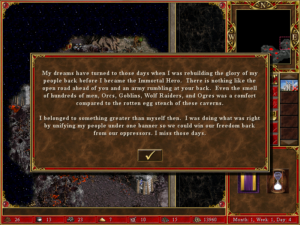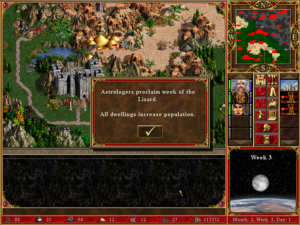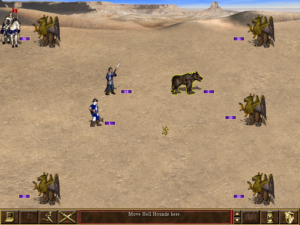Heroes Chronicles: Lamplighting
 Outside of the cities, there are free-standing buildings scattered throughout the map. Some of them, such as the training camps that improve the stats of visiting heroes, are intrinsically neutral, and will serve heroes on either side. Others can be claimed. A banner on the side indicates by its color the owner of such a structure, and typically any enemy hero passing by can change the color of that banner by tagging it. It’s possible to leave troops behind as guards to prevent this, but this is seldom if ever worthwhile, as it leaves fewer units in the hands of your heroes.
Outside of the cities, there are free-standing buildings scattered throughout the map. Some of them, such as the training camps that improve the stats of visiting heroes, are intrinsically neutral, and will serve heroes on either side. Others can be claimed. A banner on the side indicates by its color the owner of such a structure, and typically any enemy hero passing by can change the color of that banner by tagging it. It’s possible to leave troops behind as guards to prevent this, but this is seldom if ever worthwhile, as it leaves fewer units in the hands of your heroes.
Some of the claimable structures, such as mines and sawmills, provide resources to their owner every turn, and it’s very important to claim as many of these as possible — even if you don’t need the resources, it keeps them out of enemy hands. Others produce troops on a weekly basis, provided that a hero comes along to pick them up. It seems a lot less important who owns these; it just matters who can reach it, tag it, and recruit the troops first every week.
But on level 3 of Conquest of the Underworld provides a motivation to claim everything you can, even things you have no intention of using. It has to do with the “fog of war”. Every level I’ve seen so far starts out with most of the map dark, revealing it through exploration, as is typical in these games. But in levels 1 and 2, once an area was explored, it stayed explored. In level 3, the only things you can see on the map are the areas that can be seen by your heroes or from your buildings. Dark areas aren’t even considered as navigable by the game’s pathfinding algorithm if you’ve seen them before and know there’s a way through. So keeping those roadside towers under your control is an important convenience, even if you have no intention of ever recruiting what they produce. (Heroes can only have so many creature stacks under their control at a time, so recruiting everything you see isn’t always an option.) And when an enemy hero slips through, he brings darkness.
I don’t remember episode 1 well enough to know if this returning darkness is the state of most levels or if it’s a special feature of the underworld. It shows the game’s age somewhat, though. More recent games with fog-of-war effects tend to have three states: not just “visible” and “not visible”, but “visible”, “not currently visible but explored”, and “unexplored”.
 Comments(0)
Comments(0)

